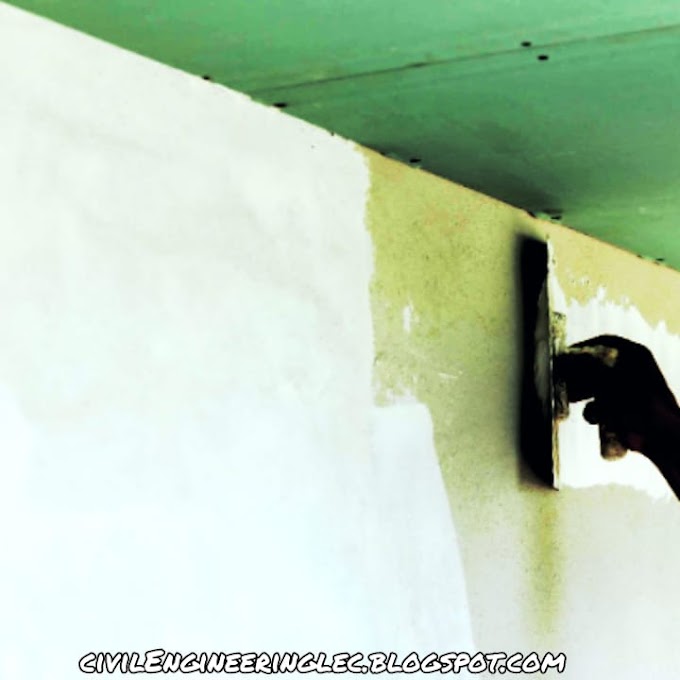Scaffolding
Whenever the height is
more than 1.5 meter while doing engineering work, it becomes difficult to work
standing on the ground. In this case a working platform is made to work, to
work at the appropriate height and to keep the material which is called
scaffolding.
Parts
Of Scaffolding
·
Standard
Scaffolding vertical
supports are called standard.
·
Ledgers
The horizontal support of scaffolding that is
parallel to the walls is called Ledgers.
·
Putlogs
The horizontal members
of the scaffolding that are perpendicular to the wall are called putlogs. One
end of them is in the wall while the other is just above the Ledgers.
·
Transom
The horizontal member
of the scaffolding that is inside the wall is called the transom. Both ends are
above the Ledgers.
·
Brace
The oblique scaffolding
of the can could be called a brace. These are used to support the stand.
·
Guard
Rail
The guard leaning
towards the Ledgers just above the scaffolding planks is called the Gurad Rail.
·
Toe
Board
The parallel planks of
Ledgers are placed on top of the scaffolding planks to prevent the workers from
falling is called toe board.
·
Raker
Oblique member in the vertical plane of the
scaffolding that supports the standard called a raker.
Types
Of Scaffolding
1. Single
scaffolding
2. Double
scaffolding
3. Cantilever
scaffolding
4. Suspended
scaffolding
5. Ladder
scaffolding
6. Tubular
scaffolding
·
Single
Scaffolding
This type of
scaffolding is much simpler in construction. This is also called brick layered
scaffolding. This is the most commonly used scaffolding. The single scaffolding
is attached with the help of vertical supports at a distance of 3 meters. A
vertical distance of 1.5 meter is kept between each Ledgers. Putlogs are tied
with these Ledgers. One end of the putlog is Ledgers while the hole is placed
in the other. The distance between the two putlogs is kept 1 to 2 meters while
their length is kept 1 meter.
 |
| Single Scaffolding |
·
Double
Scaffolding
This scaffolding is
also called mason's scaffolding. Its construction consists of two parallel lines
of vertical scaffolding which makes it quite strong. The first line of vertical
scaffolding is applied 3 cm from the wall. The ledgers are mounted at a
distance of five meters at equal height with both vertical supports. Putlogs are
tied on top of these ledgers. Both ends of the putlog above these ledgers are
above the ledgers and no head is still in the wall. This is why the wall avoids
holes. This scaffolding is mostly used for stone masonry. Because there is no
regularity in stone masonry. In addition, high quality bricks are commonly used
for masonry and painting.
 |
| Double Scaffolding |
·
Cantilever
Scaffolding
Cantilever Scaffolding
lies out of the wall like a cantilever. Scaffolding is used exclusively on the
following occasions:
o
When the space is not suitable for
vertical planting.
o
When working on the upper floors of a
multi-story building.
o
When it is necessary to protect the
street or road from obstruction.
Depending on the construction, these
scaffolding can be single or double style. This type of scaffolding is used for
minor types of work such as repairs and so on.
 |
| Cantilever Scaffolding |
·
Suspended
Scaffolding
This scaffolding is not
used in building construction. The feet of this type of scaffolding are not on
the ground but are hanging from the ceiling. It actually consists of a platform
that hangs from the ceiling through a pully with a rope. Which can be turned
upside down as needed. The advantage of this type of scaffolding is that it
does not create any obstruction on the roof.
 |
| Suspended Scaffolding |
·
Ladder
Scaffolding
ladder scaffolding is
used for all kinds of work such as painting and repair work. This scaffolding
is similar to double scaffolding. It is available in knitted condition. Its
horizontal and vertical members are attached with the help of screws and nut
bolts.
vist to more interveiw question
10 CIVIL ENGINEERING BASIC INTERVIEW QUESTIONS AND ANSWERS
·
Tubular
Scaffolding
This type of scaffolding
is also called steel scaffolding. Nowadays their use has increased a lot.It has
many benefits which are as follows.
o
It takes less time to make and remove.
o
Their scraping is also much less than
that of wooden scaffolding.
o
It is easy to increase and decrease its
length.
o
It requires less space to store after
use.
Tubular scaffolding
consists of steel pipes and fittings connecting pipes.Nut bolts are used to
attach and remove them. Iron rusts so galvanized pipe should be used.
Procedure
Of Scaffolding
o
Dig a hole 15 cm deep in the ground at a
distance of 2 meters to 2.5 meters at a distance of 1.25 meter from the wall.
o
Stand the Standards on the holes.
o
Now tie the ladger to the standard with
a rope at a height of 1.2 to 1.5 meters from the ground.
o
Now place the putlog on the wall on one
side or in the hole made in the wall and place it on the ladger on the other
side and tie it with rope.
o
Now the diagonal brace is tied with a
rope to the standard.
o
Now place the boards on the putlog so
that the working platform is closed.
o
Tie the diagonal shoring loge to the
standard for double scaffolding exterior support.
o
Use the ladder to climb the scaffolding
platform.
vist to learn mortar used in civil enginreening
Precaution
In Scaffolding Working
o
Strengthen the rope joints between the
different members.
o
Use strong up and throne.
o
Don't let too many people stand on the
platform.
o
Trap the putlog firmly into the wall



0 Comments